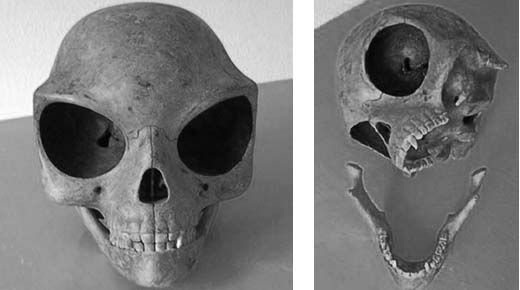Mysterious Alien Sealand skull found in Olstykke: Remains Of An Extraterrestrial
The Mysterious alien Sealand skull is one of the most controversial skulls ever excavated and has generated fascinating results leading to believe that this could be the ultimate evidence of Alien beings inhabiting Earth in the distant past.

Numerous strange and unanswered things have been discovered on Earth in recent decades. It’s difficult to differ authenticated and reliable objects from hoaxes, but discoveries like Sealand Skull are proof that there are things out there that cannot be explained precisely.
It is believed that a mysterious skull belonged to an Alien that visited Earth hundreds of years ago, others say that it may have belonged to an unknown species that roamed parts of modern-day Denmark in the distant past.
However, few think of it as just another elaborate hoax.
Tests conducted on the skull revealed fascinating results suggesting that the alien-like skull is perhaps one of the few unaccountable skulls ever found on Earth.
Facts about the mysterious Alien Sealand Skull
The enigmatic alien-like skull was discovered in 2007 in Olstykke, Denmark by workers while they were replacing sewer pipes.
Interestingly, only the skull was recovered, the skeletal remains of the body belonging to the skull have never been excavated. It is believed that skeleton of the mystery being was buried at some different location.
The skull was first examined in 2010 at the College of Veterinary Medicine in Denmark prior to 2010 not a single researcher wanted to examine the skull.
Tests conducted in 2010 revealed that the skull is one of the most mysterious craniums ever tested since experts were unable to determine what species it belonged to.
Researchers stated: “Although it resembles a mammal, certain characteristics make it impossible to fit into the Linnaean Taxonomy.”
At first, researchers suggested that the skull may have belonged to a horse, but further tests revealed the enigmatic skull belongs to an unknown species on Earth.
As no one could throw much light on the strange skull, the cranium was later sent to the Niels Bohr Institute in Copenhagen.
Carbon dating revealed that this mysterious being lived between 1200 and 1280 BC.
With the hope of finding more about the skull, researchers excavated the area where the skull was found. Among other things, they discovered animal bones, stone axes, and other artefacts that originated in the Neolithic period as per the researchers.
Some researchers proposed a theory that due to the large eye sockets and the smooth surface, it is very likely that this being was adapted to colder weather. The relative eye size indicated that it was a nocturnal creature with giant eyes.
Strangely, the eyes sockets of the Sealand skull seem to extend further to the sides whereas in a human skull eyes are more centred.
The nostril of the Sealand skull is very small, and the chin is very narrow
If the species of this mysterious skull does not fall into the category of a known species on earth, then who does it belong to?





